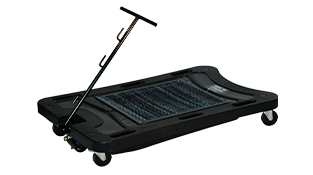Sage Oil Vac preseason maintenance checklist

Busy season is just around the corner, so now is the time to make sure your mobile lube equipment is ready to work hard. Follow this comprehensive preseason maintenance checklist to help keep your equipment, accessories and work environment safe and reliable.
Air compressors
It’s crucial to maintain your Sage Oil Vac unit’s air compressor. Follow the recommended maintenance schedules for the engine and the compressor pump.
- Perform an oil change on the engine and pump at least once a year, regardless of use on your system.
- Replace intake air filters at least once a year.
- Drain compressor air tanks daily during use to properly maintain the compressor.
Sage Tip: Operating your Sage Oil Vac continuously with the used oil tank completely full could result in a large amount of used oil accumulating within the compressor heads and air tanks. To avoid this, it’s important to unload the used oil tank before it exceeds 95% of its capacity.
Ball valves
- Check that the actuation on each ball valve is tight so they don’t open or close during routine travel to the jobsite.
Cam locks
- Install caps and plugs on cam lock fittings to reduce drips and spills.
- Check that both actuating arms on female cam connections are working to secure a good connection.
Filters
- Change all fresh fluid filters twice a year, or after every 1,000 gallons of oil filtered.
Hose reels
- Check the spring-latch assembly of the hose reel to ensure it is performing properly.
- Grease the grease swivels at least once a year, and more often for heavy use depending on the model. If you are unsure about the requirements of your model, just ask your Sage Oil Vac dealer.
- Double-check that all ball stops are installed and tight to keep the proper hose reel tension.
Hoses
- Check the outer hose covers for any gouges or wear — this is especially important on spring-retractable hose reels.
- Look for spots where oil is seeping through the outer cover, as this could indicate that the inner lining of the hose is torn.
Hydraulic connections
- Clean off any grime or dirt from the hydraulic fittings for a secure connection to meters and equipment.
- Promptly address any leaks.
Lug nuts
- Tighten lug nuts on trailer wheels to the proper torque (tightness). A good rule of thumb is to check after the first 10, 25 and 50 miles of driving, before each tow, and at least twice a year thereafter.
- Note: Incorrect wheel nut torque is a major reason lug nuts loosen in service. Loose lug nuts can rapidly lead to a wheel separation and serious safety consequences. Also note that overtightening can result in breaking the studs or permanently deforming the mounting stud holes in the wheels.
Sage Tip: Keep a record of the date and approximate mileage of your last torque check somewhere on or inside your equipment. Make note of any lug nuts that are loose and investigate why. If a lug nut becomes loose after retightening, something is wrong with it, the studs, wheels and/or hubs and must be corrected.
Meters
- Check batteries on electronic meters.
- Regularly clean high-flow non-drip ends for a proper close to minimize drips and spills.
Running lights
- Check that all brake lights, turn signals, license plate lights and market lights work correctly.
Tires
- Check the condition of the tire tread.
- Make sure there is adequate air pressure.
- Inspect for gouges or other defects.
Sage Oil Vac tanks
- Annually flush out the used oil tank to remove sludge and other contaminants that have been vacuumed out of engines and drain pans with debris.
- Here’s how: vacuum 5-10 gallons of diesel, pressurize the tank (no more than 5 psi) and dispense the fluid to flush the tank and hose circuit. This same method can be used to switch fluids in new oil tanks if necessary (i.e., switching a 15W-40 motor oil tank to a hydraulic fluid tank).
Wheel bearings
- Grease wheel bearings every 12 months or 12,000 miles, whichever comes first.
- Note: You can use red grease for trailer wheel bearings or wheel bearing grease, which is specially designed for use on trailer-running gear. Wheel bearing grease has a slightly higher temperature rating of 520 degrees, compared to 510 degrees for red grease.
- Inspect the bearings and races before repacking them.
- Replace the grease seals.
Sage Tip: Incompatible greases can break each other down. Make sure new grease is compatible with the old. If not, remove the old grease completely.
>> Download and print this checklist
Take inventory to boost efficiency
Before the busy season starts is also a good time to find ways to boost your efficiency. Consider adding new machinery or upgrading accessories to your existing equipment. Contact your Sage Oil Vac dealer for any of your product needs and with any questions about preseason maintenance.

















